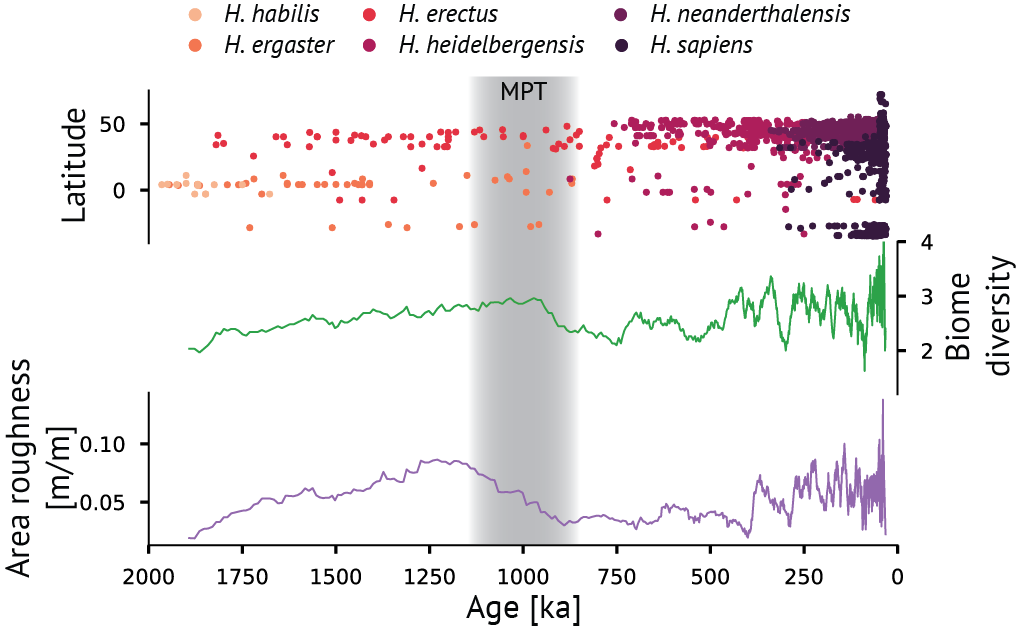A new study published in the journal Science Advances [1] by researchers at the IBS Center for Climate Physics (ICCP) at Pusan National University in South Korea shows that the patchwork of different ecosystems found in mountainous regions played a key role in the evolution of humans.
A notable feature of the archeological sites of early humans, members of the genus Homo known as hominins, is that they are often found in and near mountain regions. Using an extensive dataset of hominin fossils and artifacts, along with high-resolution landscape data and a 3-million-year-long simulation of Earth’s climate, the team of scientists from ICCP have provided a clearer picture of how and why early humans adapted to such rugged landscapes. In other words, they have helped explain why so many of our evolutionary relatives preferred being “steeplanders” as opposed to “flatlanders.”
Mountainous regions have enhanced biodiversity because the changes in elevation result in shifts of the climate, providing a range of environmental conditions under which different plant and animal species can thrive. The authors showed that steep regions usually exhibit a larger variety and density of ecosystems and vegetation types, known as biomes. Such biome diversity was a draw for early humans, as it provided increased food resources and resilience to climate change, an idea known as the Diversity Selection Hypothesis [2].
“When we analyzed the environmental factors that controlled where human species lived, we were surprised to see that terrain steepness was standing out as the dominant one, even more than local climate factors, such as temperature and precipitation.“ said Elke Zeller, PhD student from the IBS Center for Climate Physics and lead author of the study.
On the other hand, steep regions are more difficult to navigate than flatter terrain and require more energy to traverse. Hominins needed to gradually adapt to the challenges of rougher terrain in order to take advantage of the increased resources. The ICCP researchers examined how, over time, human adaptations changed the cost-benefit balance of living in rugged environments.
The adaptation towards steeper environments (Figs. 1 and 2) is visible for the earliest human species Homo habilis, Homo ergaster, and Homo erectus until about 1 million years ago, after which the topographic signal disappears for about 300,000 years. It reemerges again around 700,000 years ago with the advent of better adapted and more culturally advanced species such as Homo heidelbergensis and Homo neanderthalensis. These groups, which were able to control fire, also exhibited a much higher tolerance for colder and wetter climates.
“The decrease in topographic adaptation around 1 million years ago roughly coincides with large-scale reorganizations in our climate system, known as the Mid-Pleistocene Transition. It also lines up with evolutionary events such as a recently discovered ancestral genetic bottleneck, which drastically reduced human diversity, and the timing of the chromosome 2 merger in hominins. Whether this is all a coincidence, or whether the intensifying glacial climate shifts contributed to the genetic transitions in early humans, remains an open question,” said Axel Timmermann, Director of the IBS Center of Climate Physics and co-author of the study.
How humans have evolved over the past 3 million years and adapted to emerging environmental challenges is a hotly-debated research topic. The results of the South Korean research team provide a new piece in the puzzle of human evolution. Averaged over hundreds of thousands of years, across different species and continents, the data clearly show that our ancestors were “steeplanders.” “Our results clearly show that over time hominins adapted to steep terrain and that this trend was likely driven by the regionally increased biodiversity. Our analysis suggests that it was beneficial for early human groups to populate mountainous regions, despite the increased energy consumption needed to scale these environments,” said Elke Zeller in summary.


[1] The evolving 3-dimensional landscape of human adaptation, Elke Zeller, Axel Timmermann, Science Advances, doi: 10.1126/sciadv.adq3613, (2024)
[2] Human adaptation to diverse biomes over the past 3 million years, Elke Zeller, Axel Timmermann, Kyung-Sook Yun, Pasquale Raia, Karl Stein and Jiaoyang Ruan, Science, vol. 380, 6645, pp. 604-608, doi: 10.1126/science.abq1288 (2023)
Notes for editors
– References
The evolving 3-dimensional landscape of human adaptation, Elke Zeller, Axel Timmermann, Science Advances, DOI: 10.1126/sciadv.adq3613
– Media Contact
For further information or to request media assistance, please contact: U-Jeong Seo, IBS Center for Climate Physics, Pusan National University (+82-51-510-7328, u_jeongs@pusan.ac.kr)
– About the Institute for Basic Science (IBS)
IBS was founded in 2011 by the government of the Republic of Korea with the sole purpose of driving forward the development of basic science in South Korea. IBS has 34 research centers.
– About ICCP
The IBS Center for Climate Physics (ICCP) expands the frontiers of earth system science by conducting cutting-edge research into climate dynamics and utilizing high-performance computer simulations to elucidate how climate has shaped human history and to improve decadal Earth system forecasts and long-term climate, sea-level and biogeochemical projections. See more on http://ibsclimate.org.